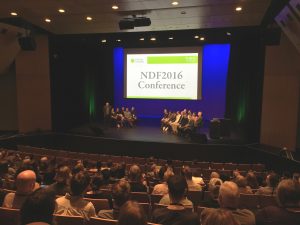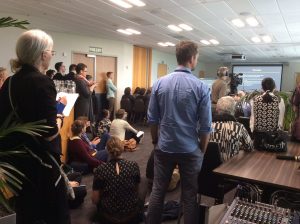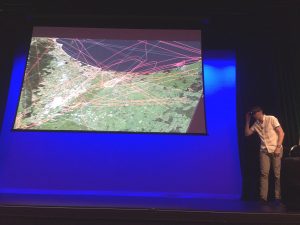
This year around 320 people attended the National Digital Forum Conference (NDF) at Te Papa, Wellington. Despite aftershock rumblings and high nerves from a city recovering from an earthquake, the conference went ahead without a hitch.
This was my first year attending the conference and I was amazed at the fascinating presentations and the challenging ideas we were left with. Sadly, I am just one person and I was unable to visit all of the presentations I wanted to. But I am looking forward to watching all of the speakers on the NDF YouTube channel. There were so many ideas and concepts thrown around but the two main themes seemed to be collaboration and a people first attitude.
Collaboration breeds success
Firstly, congratulations are in order for Tusk Culture who won two of the six awards presented at the NDF conference. Tusk Culture won the “Great Collaborator” and “The Big Takeaway” awards.
Tusk provides a platform for emerging professionals to engage, promote and provoke positive change in the GLAM sector. They allows individuals to be recognised for the role models they are in the GLAM sector and they foster critical thinking in the future leaders of the sector. Articles are contributed across the sector and the topics covered are as interesting as they are diverse. Collaboration is at the core of Tusk Culture and its success is well deserved.
Palmerston North Library and Massey University Technology Summer Challenge

The staff at the Palmerston North Library had a growing problem. They had three 3D printers but none of the staff had enough expertise to operate them. They wanted to use this new technology to educate and inspire the community, but weren’t sure how they could accomplish it. Massey University Engineering noticed a different problem. They were struggling to recruit high-schoolers into engineering. Even more, they were failing to capture the interest of young girls in STEM. The two institutions uncovered their shared interests when a few engineering students asked to borrow the Library’s 3D printers to complete a project. Visitors young and old were fascinated and inspired by the things the students were creating on the printers.
So the Palmerston North Library and Massey University Engineering combined together to create the Technology Summer Challenge. The Library staff and an engineering 4th year student worked together to get children to make robots. The results were a hit! Parents and children loved the programme and there were an equal amount of girls and boys involved. The local community were enthused about STEM and engaged with both Massey University and the Palmerston North Library. This challenge was repeated late in the year and was equally successful. By working together, Palmerston North Library staff gained experience with different forms of technology and Massey University was able to inspire interest in STEM.
People at the Centre
Ngai Tahu Cultural Mapping Project
Takerei Norton gave an inspiring keynote speech on the second day of the conference. The Ngāi Tahu Cultural Mapping Project uses GIS to map the stories, travel routes, place names and other areas of cultural significance in Ngāi Tahu history onto the South Island of New Zealand. The Ngāi Tahu have also developed a reference system to connect the historical documents and oral history with the GIS maps.

The Ngāi Tahu Cultural Mapping project has created and collated a wealth of information and is an impressive feat. This project demonstrates how local communities and iwi are more than capable of becoming trustees of the past. Especially when it is their own past. As Takerei said, the cultural mapping project “was successful because it wasn’t done for us. It was done by us”. They don’t need museums to run the projects they just need access to the documents and archives held by museums, galleries and libraries. Digitising museum and archive collections reconnects those items to their context. When people are able to easily access and remix museum and archive collections, they engage with their heritage; they take ownership.
Audience Engagement
As Adam Moriarty, Auckland War Memorial Museum, (winner of the Big Thought Award) says, we should be “open by default, closed by exception”. Siobhan Leachman (@SiobhanLeachman) echoed this sentiment, stressing that we “need to be generous with our content” and trust our communities. What we count as engagement she calls playing. When people are playing with your content and data, you discover the stories, the history, and the people behind the objects. Like when Richard Foy discovered his own grandmother in the National Archives, or when people discover their friends, families and themselves in the Swainson-Woods Puke Ariki project.
But audience engagement (playing) can provide so much more than personal stories. Our communities can be used to transcribe, correct spelling errors, fact check, and expand our knowledge about our collections. But if we want any of those benefits we have to provide something in return. We need to be open, and we need to be generous.
Conclusion
The 2016 NDF conference may have been about digital but really it was all about people. As Richard Foy so eloquently said in his opening address,
“We need to put people first! Our collections, our websites, our big data, our institutions should revolve around people at the heart of it.”

Data and technology are fantastic tools. But they are just that, tools. There seems to be a rising pressure to have the newest and latest technology to prove your relevance as an institution.
But the most successful projects discussed at the conference weren’t focused on using new technology for the sake of technology. They weren’t trying to prove they were still relevant to the communities. The successful projects simply saw a need in their community and used the digital toolkit to enable, educate and engage those around them.
I can’t summarize any better than Matthew Oliver has in his closing remarks “This isn’t about making ourselves relevant. We need to get past arguing that we’re relevant and just be relevant… Our sector has role here, in building a society where people want to look after each other, and where hate can’t survive.”
We have a responsibility to our communities and to ourselves to stand up and stand out. To be a source of education, knowledge, connection and community. To be collaborative and to have people at the centre.